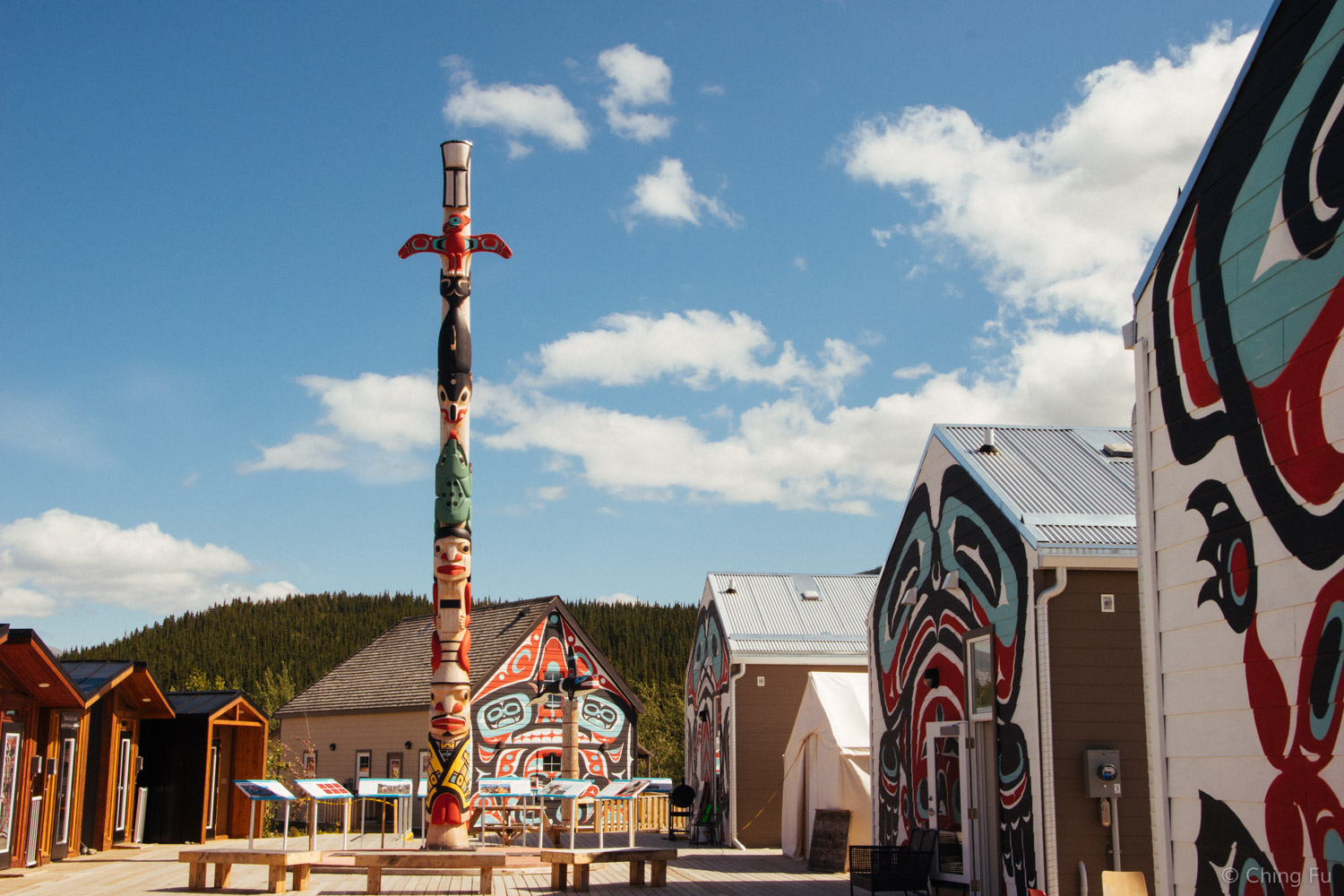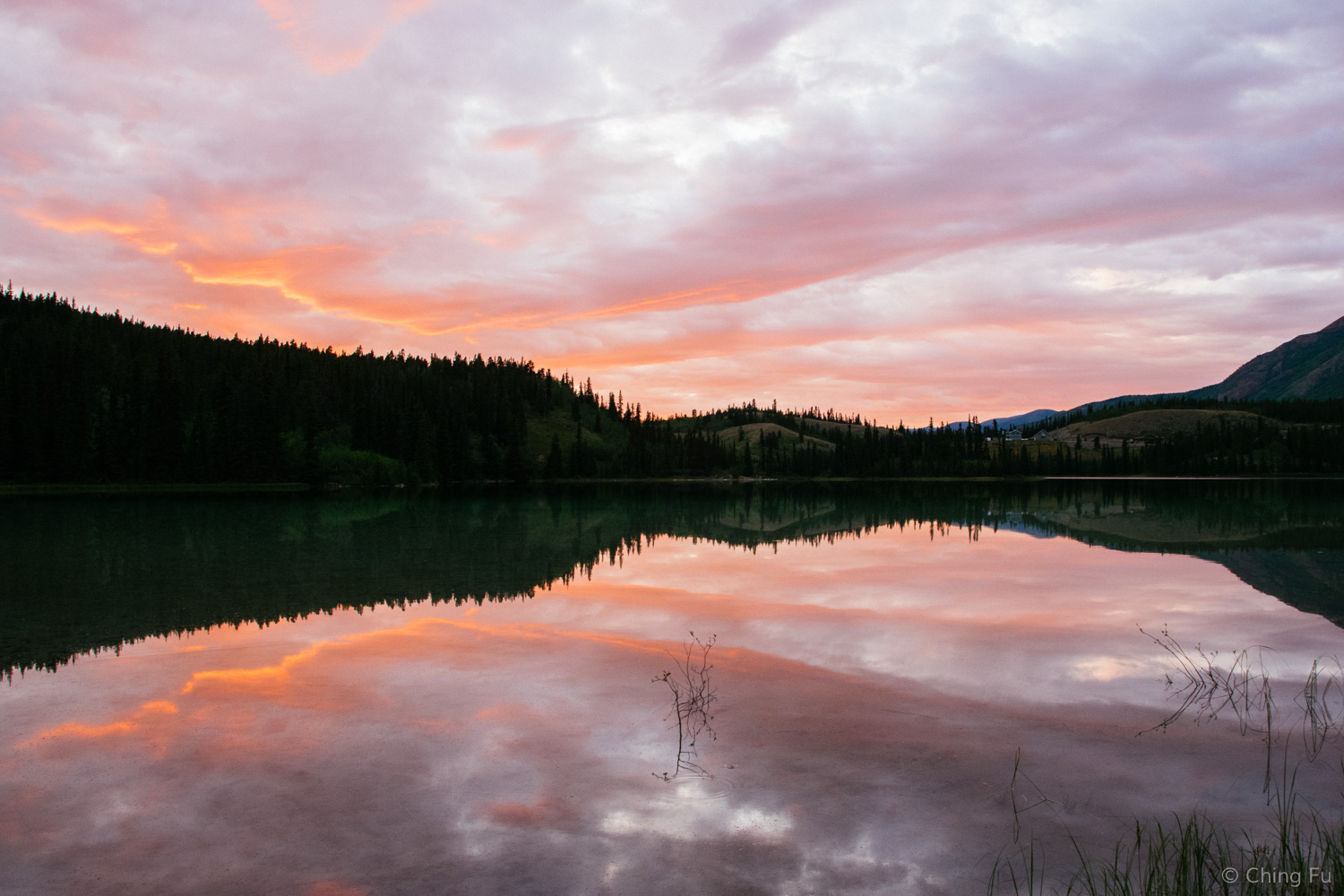Glamping In Carcross, Yukon
Carcross was originally named Caribou Crossing because of the large numbers of caribou in the area. In 1904 the name was changed because Alaska, British Columbia and the Klondike all had towns with the same name and it caused confusion in mail services. The town of Carcross is 44 miles southeast of Whitehorse and is making a name for itself as a mountain biking destination in Yukon because of the trails on Montana Mountain. We chose to visit the area to check out the mountain biking and hiking trails.
Emerald Lake
Despite having two tents with us (don’t judge), we unfortunately don’t use them very often. So you can imagine our excitement when we found a perfect place to set up a tent to camp. We initially wanted to park the Toaster in that spot, but because it was tucked away in the woods it was too shady for our solar panels. Still wanting to be able to hang out in the woods, we realized we could park the Toaster beside the gravel road nearby, and camp in a tent by the lake instead. It really was the best of both worlds: the Toaster got full sun parked by the gravel road; it was a short walking distance from the tent to the Toaster but neither was visible from the other; we could sleep in a tent, play in the lake, and hang out in the woods but still have all the amenities of the Toaster. This was better than car camping. This was glamping at its finest.
Emerald Lake is a stunning blue-green lake right off the Klondike Highway (Yukon Highway 2). From the highway, there’s a large pull out that overlooks it and provides the best lake-view (other than hiking up the mountains above it). Floating in a boat on the lake, I watched lots of cars, RVs, and tour buses stop and unload to get photographs. The more eager travelers drove down to where we were camped and walked out to the edge of the water for a more intimate view (this didn’t happen too often).
The water was cold, but on sunny days it felt so good to go swimming. The lake bottom consisted of this squishy ash-like sediment that would suck your feet in as you walked into the water, kind of like quicksand. The white sediment is called marl and made of fragments of decomposed shells mixed with clay. On our side of the lake bottom it was especially soft. But I found the perfect swimming spot a short paddle across the lake where the bottom was firmer and the shore was covered with the same tiny shells that create the marl. Staying a mere 250 ft. away from the lake meant we could go play in it whenever we want – go for a swim after a hike, paddle out with the dogs, or just float in the boat and read. Having such easy access to a scenic lake was heaven for Tybee and me. We spent as much time on and in the water as we could when the sun was out and warmed up by the campfire in the evenings. Not to mention the joys of sleeping in a tent, but also being able to sleep in the RV on rainy days.
Dog couch
Breakfast over a fire!
The Toaster was surrounded by water as the result of a heavy rainstorm.
This was one of our top boondocking sites. So it was especially heartbreaking when two First Nation government employees visited us at the Toaster to tell us we weren’t allowed to stay there…
First Nations
On our 7th day staying at Emerald Lake a pickup truck pulled up and two First Nations guys knocked on our door. They were First Nation government employees and they came to tell us (very politely) that we couldn’t stay at Emerald Lake because we were on their land. They said they had gotten a call complaining about us, how some locals had approached us telling us we couldn’t stay and we were rude and vulgar to them. After talking to us, I think they soon realized that wasn’t us. Frank and Corey asked why we weren’t staying at the Carcross Tagish First Nation’s campground, which is a fee-based campground for tent campers and RVers. We told them that we preferred boondocking to campgrounds and that we had checked out the campground but there was too much tree coverage for our solar panels. Their attitude towards us changed after we told them that our RV is 100% powered by solar panels. When they first arrived, they wanted us to leave immediately but after learning about our solar, they said that we could stay until the end of the week (5 extra days).
Carcross Commons, the retail center of town where the visitor center is also located. The murals on the building represent the Six Clans associated with the Carcross Tagish First Nation.
Our conversation with Corey and Frank ended up being really interesting. The Carcross/Tagish First Nation is a fairly new government, established in 2006. They are still learning and figuring out a lot about land management and use, especially as they open their doors to tourism. Corey asked us a lot of questions about the Montana Mountain trails after we told him we had mountain biked there. It seemed like Corey was either a mountain biker or very involved with the trail project. He voiced his worries about the interaction between mountain bikers and the jeep tours that occur on the mountain. The jeeps drive down the main gravel road really fast, which is a safety issue because some of the mountain bike trails cross that road. It also kicks up a lot of dust, which is annoying to riders who cycle up the gravel road to get to the trails. Corey also mentioned the difficulty of trying to balance the land use on Montana Mountain between the First Nation elders and the younger generations. The elders still use the mountain as they always have, which includes hunting, and that’s caused some concerns as hikers and mountain bikers recreate on the same mountain.
The Carcross/Tagish government building.
Frank and Corey had asked us to drop by their office to fill out some paperwork to get proper permission to stay at Emerald Lake. When we arrived at the government building, Frank brought us upstairs where our conversation from earlier continued. Frank told us that Carcross has a strict local building code to ensure that new structures are built in a way that blends in with the environment and their culture. As the town starts to develop more, they want to ensure it doesn’t turn into a kitschy tourism town. They are also very focused on using alternative energy methods: the learning center that’s in the construction phase next door will be outfitted with solar panels and there’s talk of testing out wind turbines on the shore or just inland of Bennett Lake (it’s a very windy lake).
You can walk to Bennett Lake from "downtown" Carcross.
One wall of the room was fully covered with large maps outlining First Nation land in that specific region. They are not contiguous land but individual plots scattered across Whitehorse, Marsh Lake, Carcross and the town of Tagish. Taking care of the land and wildlife is a priority for the First Nation people. Frank pointed out on the map how each First Nation land is coded by a certain letter stating how it can be used. For example, the west side of Marsh Lake is First Nation land and is classified as class A land. This means that it can’t be commercially used without full consent from the First Nation. The land by Marsh Lake, along with other plots of land, has natural resources under it (like gas) that they are trying to protect from commercial extraction. Frank mentioned how years ago (within our lifetime) the mountains in Carcross looked like they were moving because they were covered with caribou. The caribou population has decreased so much because of human encroachment (homes and roads). He said the Carcross/Tagish First Nation people have proactively and willingly stopped hunting caribou to help the population. To not hunt caribou is a very big sacrifice for the First Nation people. Caribou is an integral part of their culture and it’s a huge sacrifice for them that the younger generations don’t know how to hunt or use caribou. I asked Frank if they’ve investigated creating wildlife corridors, specifically overpasses, to help wildlife move through the area. He said that there was actually a meeting happening downstairs, as we spoke, about wildlife overpasses. It was really wonderful to see the amount of thought and energy the Carcross/Tagish First Nation was putting into the future of the land. The land and wildlife relationship to the First Nation people is more important than money – which is rare to see in this day and age.
A beautiful and rare sunset over Emerald Lake. We were in Carcross when it wouldn't get dark until well past 1 AM and only briefly before the sun came back up again. It was strange to be able to read a book inside the tent without a headlamp at midnight. Yukon is known as land of the midnight sun.
TIPS:
- The town of Carcross has a water fill station located in town. It’s free. I forgot to get the street address, but it's past the library near the Bennett Lake observation platform (the town is tiny). There isn’t water available at the Carcross Tagish First Nation’s campground.
- There is a dump station at the Carcross Grocery and RV Park. It’s CAD $12 (we never had to use it). I’m assuming there’s also fresh water available there.
- Carcross Grocery and RV Park also has a convenience store with a limited amount of real food (the staples). The closest grocery store is back in Whitehorse.
- The Carcross public library and visitor center both have free WiFi.
We were here from July 4 – July 16, 2016.












